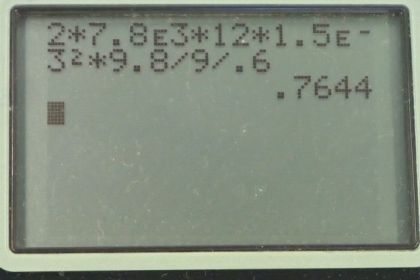Question
Stokes' law describes sedimentation of particles in liquids and can be used to measure viscosity. Particles in liquids achieve terminal velocity quickly. One can measure the time it takes for a particle to fall a certain distance and then use Stokes' law to calculate the viscosity of the liquid. Suppose a steel ball bearing (density , diameter 3.0 mm ) is dropped in a container of motor oil. It takes 12 s to fall a distance of 0.60 m. Calculate the viscosity of the oil.
Final Answer
Solution video
OpenStax College Physics, Chapter 5, Problem 28 (Problems & Exercises)

vote with a rating of
votes with an average rating of
.
Calculator Screenshots
Video Transcript
This is College Physics Answers with Shaun Dychko. We are going to calculate the viscosity of motor oil and a steel ball bearing is dropped into the oil and it achieves its terminal velocity really quickly and that piece of information tells us that the speed of this ball is essentially the distance it falls divided by time. We don't need to consider any period of time when it's accelerating; we are told that it finishes its acceleration and reaches its terminal velocity right away. So the speed v in this Stoke's law is going to be just this distance traveled which is 0.6 meters divided by time. Now the fact that it's steel means that to find its mass— which we need to know in order to calculate gravity— knowing that it's steel, we can use its density and its radius to calculate the volume and in turn, calculate the mass using our density formula which says density is the mass divided by its volume and we can rearrange this to solve for m which we'll then substitute in for m in our gravity formula. Okay! So I wrote down the information that we know taking care of a bit of unit conversion here as I usually do in this step here so that we don't have to think about it later— this 3 millimeter diameter— but we are interested in the radius because the volume formula is 4/3π times radius cubed—that's the volume for a sphere. So I divided the diameter given by 2 and then also converted the millimeters into meters by multiplying by 10 to the minus 3. The time it takes to fall is 12 seconds and the distance covered we already said and there's the density. Okay! So Stoke's law says that the force the drag force this tiny thing will experience is going to be 6 times π times its radius times the viscosity of the fluid that we are going to find multiplied by its speed. So the terminal velocity means that the force upwards equals the force downwards and that's what we say here and then this force downwards is gravity so it is mg and now we need to substitute for m because we are not given m directly, we are given the density of this material—steel— and we can find its volume given the radius. So multiply both sides by the volume V and we get m is density times volume and then replace volume with the sphere volume formula: 4/3πr cubed. So that all gets plugged in for m in our formula for gravity which is in turn equal to Stoke's force. And then we also need to be aware that the speed of this thing is its distance traveled divided by time and then we do a whole bunch of substitution's in this line. So I switched the sides around so we have the unknown η on the left and here it is and replacing V with distance over time replacing the force due to Stoke's law with mg but where m is this business here and so that's what's written here and then we do a little bit of algebra to solve for the viscosity. So we multiply both sides by t over 6πrd. So this r... (well, let's finish this step here, okay) so this cancels everything on the left except for the viscosity so it's isolated now which is good and then on the right hand side, 4 divided by 6 is 2 over 3 and then the 3 times this 3 in the denominator makes 9 and we are left with the 2 on top still; this r cubed divided by r makes r squared and π divided by π means it's gone and there's a t factor introduced here and then we have this g copied and d is in the denominator— this is the diameter. So plug in numbers: we have 2 times the density of steel times 12 seconds times the radius squared times acceleration due to gravity divided by 9 times—the distance that it falls—0.60 meters giving a viscosity of 0.76 kilograms per meter per second.
